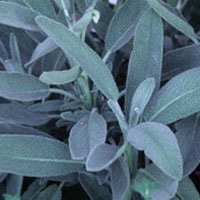Gluten Free
What does following a gluten-free diet mean? That you're embarking on an easy diet with a wide range of health-promoting effects. Instead of dwelling on what you’re giving up, consider that you’re going to enjoy a whole new world of delicious food options to meet your special dietary needs. You’ll be eating seasonally, choosing more fresh fruits and vegetables, focusing on meats, seafood, poultry, legumes, lentils, corn, and rice, and discovering fascinating ancient grains such as quinoa, amaranth, and millet. You’ll be able to eat potatoes, eggs, most cheeses, even chocolate (!)—and enjoy them without guilt because you’ll be taking good care of your body. In fact, you’ll probably end up eating—and feeling—better than ever!
Visit this page for more information about living Gluten Free
---
We carry a large variety of gluten free items, the brands listed below represent just some of the offerings we carry















More Diets
Sage
 © Steven Foster
© Steven FosterParts Used & Where Grown
Sage is a silvery-green shrub with very fragrant leaves. The most commonly cultivated species of sage originally came from the area around the Mediterranean but now also grows in North America. The leaves of this common kitchen herb are used in medicine as well as in cooking.1
- Reliable and relatively consistent scientific data showing a substantial health benefit.
- Contradictory, insufficient, or preliminary studies suggesting a health benefit or minimal health benefit.
- For an herb, supported by traditional use but minimal or no scientific evidence. For a supplement, little scientific support.
Our proprietary “Star-Rating” system was developed to help you easily understand the amount of scientific support behind each supplement in relation to a specific health condition. While there is no way to predict whether a vitamin, mineral, or herb will successfully treat or prevent associated health conditions, our unique ratings tell you how well these supplements are understood by the medical community, and whether studies have found them to be effective for other people.
For over a decade, our team has combed through thousands of research articles published in reputable journals. To help you make educated decisions, and to better understand controversial or confusing supplements, our medical experts have digested the science into these three easy-to-follow ratings. We hope this provides you with a helpful resource to make informed decisions towards your health and well-being.
This supplement has been used in connection with the following health conditions:
| Used for | Amount | Why |
|---|---|---|
Alzheimer’s Disease | 60 drops daily of a 1:1 tincture | Sage appears to have an effect on acetylcholine, one of the chemical messengers (neurotransmitters) in the brain and supplementing with sage has resulted in a significant improvement in cognitive function. |
Gingivitis (Caraway, Chamomile, Clove Oil, Echinacea, Menthol, Molmol, Peppermint) | 0.5 ml in half a glass of water three times per day swished slowly in the mouth before spitting out | A mouthwash containing sage oil, peppermint oil, menthol, chamomile tincture, expressed juice from echinacea, myrrh tincture, clove oil, and caraway oil has been used successfully to treat gingivitis. |
Indigestion, Heartburn, and Low Stomach Acidity | 4 to 6 grams daily of dried leaf or equivalent, for indigestion | Sage is a gas-relieving herb that may be helpful in calming an upset stomach. |
Menopause (Alfalfa) | 4 to 6 grams daily of dried herb or equivalent | Supplementing with sage leaf and alfalfa extract completely eliminated hot flushes and night sweats in 20 of 30 women in one study. |
Common Cold and Sore Throat | Refer to label instructions | Sage tea may be gargled to soothe a sore throat. |
Halitosis | Consult a qualified healthcare practitioner | Volatile oils made from sage have antibacterial properties and may be effective in mouthwash or toothpaste form. |
Infection | Refer to label instructions | Sage is an herb that directly attack microbes. |
Menopause | Refer to label instructions | Sage may reduce excessive perspiration due to menopausal hot flashes during the day or at night. It is believed this is because sage directly decreases sweat production. |
Pregnancy and Postpartum Support | Refer to label instructions | Sage has traditionally been used to dry up milk production when a woman no longer wishes to breast-feed. |
Traditional Use (May Not Be Supported by Scientific Studies)
Sage has one of the longest histories of use of any culinary or medicinal herb. It was used by herbalists externally to treat sprains, swelling, ulcers, and bleeding.2 Internally, a tea made from sage leaves has had a long history of use to treat sore throats and coughs—often used as a gargle. It was also used by herbalists for rheumatism, excessive menstrual bleeding, and to dry up a mother’s milk when nursing was stopped. It was particularly noted for strengthening the nervous system, improving memory, and sharpening the senses.3 Sage was officially listed in the United States Pharmacopoeia from 1840 to 1900.
Copyright © 2025 TraceGains, Inc. All rights reserved.
Learn more about TraceGains, the company.
The information presented by TraceGains is for informational purposes only. It is based on scientific studies (human, animal, or in vitro), clinical experience, or traditional usage as cited in each article. The results reported may not necessarily occur in all individuals. Self-treatment is not recommended for life-threatening conditions that require medical treatment under a doctor's care. For many of the conditions discussed, treatment with prescription or over the counter medication is also available. Consult your doctor, practitioner, and/or pharmacist for any health problem and before using any supplements or before making any changes in prescribed medications. Information expires December 2025.











